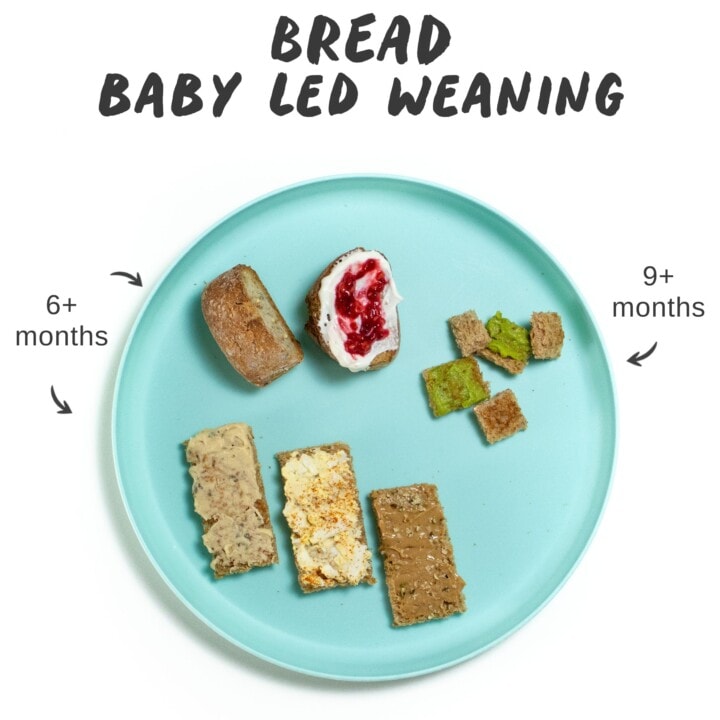Bread for Baby (plus Best Toast Options)
Bread is a quick and cost-friendly source of carbohydrates, protein and fiber for babies 6 months and up. In this guide, learn how to serve bread to your baby, for baby-led weaning or finger feeding. Plus, we’ll share the best toast options for babies and toddlers!

Medically reviewed and cowritten by Jamie Johnson, Registered Dietitian Nutritionist (RDN), and Lauren Braaten, Pediatric Occupational Therapist (OT).
Bread for Babies
Not much beats the smell of freshly baked bread, right out of the oven (or toaster!). And thankfully, your baby can also get all the deliciousness and health benefits that you can from a toasty slice of bread, no matter if it’s homemade or store-bought.
Bread is a quick and easy source of carbohydrates, protein and fiber for your baby, depending on what type of bread you choose to serve. So how do you serve bread safely for baby led-weaning or if your baby is starting finger foods?
You’ve come to the right place! In this guide, we’ll cover all the information you need in order to serve bread to baby. You’ll learn about the nutritional benefits, FAQs, helpful tools and expert feeding tips.
First time making homemade baby food? Then, I would suggest that you start by reading my very in-depth Complete Guide to Baby-Led Weaning – which covers what exactly is baby-led weaning, to every parent’s concern of baby-led weaning and choking, this guide goes over it all. I will also share how to know when baby is ready for BLW, the top 10 best first foods, a helpful sample blw feeding schedule, helpful tools to have on hand, and much much more! You can also check out my best-selling cookbook for even more information and recipes!
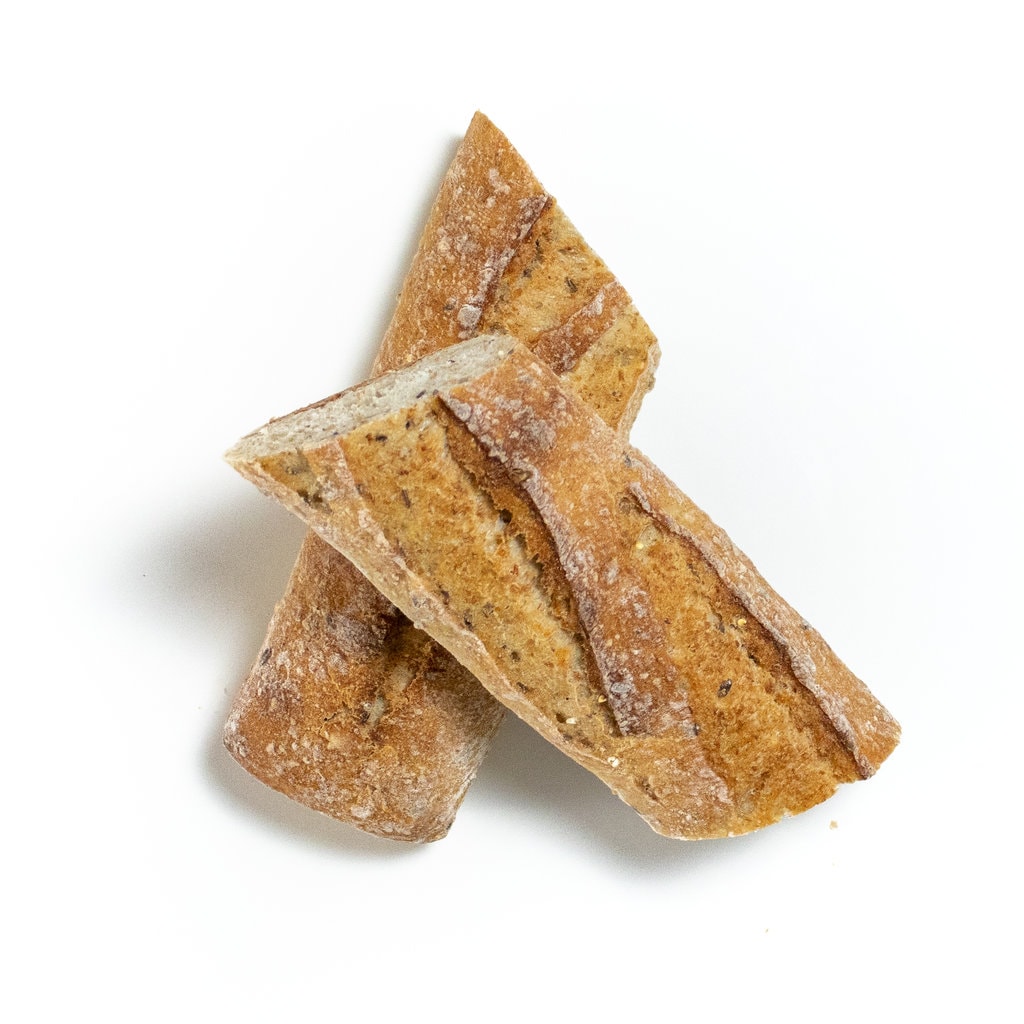
Reasons to Love Bread for Baby
- Great for baby-led weaning – 6+ months
- Also great for the finger food stage – 9+ months
- Full of essential nutrients for baby
- Different ways for baby to eat
- Easy to make – minimal prep work required
Health Benefits of Bread
Bread gets a bad rap but, depending on the type, it can be full of healthy nutrients.
- Bread is full of carbohydrates necessary for energy and fueling the body.
- If it’s whole grain bread, it will have fiber for a healthy digestive system.
- Whole grain bread will also have other nutrients, too, like B vitamins and iron. Enriched bread has these nutrients added back to it, but usually not in the amount found in whole grain bread.
Frequently Asked Questions
The best bread for your baby will be a somewhat personal decision; however, there are a few factors to keep in mind. You’ll want to choose one that’s lower in sodium and added sugars (no honey for babies under 1 year) and doesn’t have any large nuts or seeds (choking hazard). Ideally, you want a bread that’s made with whole grains, easy to toast, and is affordable for you and your family.
Bread may be introduced around the time that baby is ready to start solids, although you may want to wait to serve it until many common allergens that are typically in bread (such as wheat, milk, egg, sesame, soy, tree nut) have been introduced separately.
Depending on how it is served, yes. When chewed, bread softens and clumps together, which may cause it to stick to the roof of baby’s mouth or tongue. Serving bread toasted helps to remove some of its moisture, so it’s less likely to stick together in a ball. You can also spread a thin layer of a smooth condiment on toast, such as butter, nut butter, hummus or mashed avocado, which helps to minimize choking risks.
Yes, depending on the variety, bread usually contains at least a few common allergens, such as wheat, milk, egg, sesame, soy, or tree nuts. It’s best to wait to introduce breads until all common allergens on the list have been safely introduced and read labels carefully.
Best Bread Brands for Babies
What to Look For
The best bread for your baby may depend on a few factors – your family’s preferences, any food allergies, cost, etc. However, there are a few factors that are helpful to keep in mind when choosing bread for baby.
- Low in sodium: Look for those with 100 milligrams or less per serving.
- No added sugars: Look for breads with no added sugars in their ingredient list or at least no more than 2 grams of sugar per slice. And don’t forget – no honey for babies under 1 year of age, so skip any breads with honey as an ingredient.
- Made with whole grains or sprouted grains: These options will offer more nutrients and fiber compared to traditional white bread.
Best Brands
The best bread brands for baby-led weaning include types of breads that are a little crustier or sturdier and can hold their ground when being picked up by little fingers (when toasted and cut into strips). Here are several of our favorite brands for reference.
- Food for Life Ezekiel 4:9 Sprouted Whole Grain Bread
- Simple Truth Organic Sprouted Grain and Legume Bread
- Dave’s Killer Bread 100% Whole Wheat
- Whole Foods Organic Whole Wheat Sandwich Bread
- New Grains Gluten Free Artisan Sourdough Bread
- Silver Hills brand
Tip on Bread: Avoid breads that contain honey if serving to babies under 1 year old due to the risk of infant botulism.
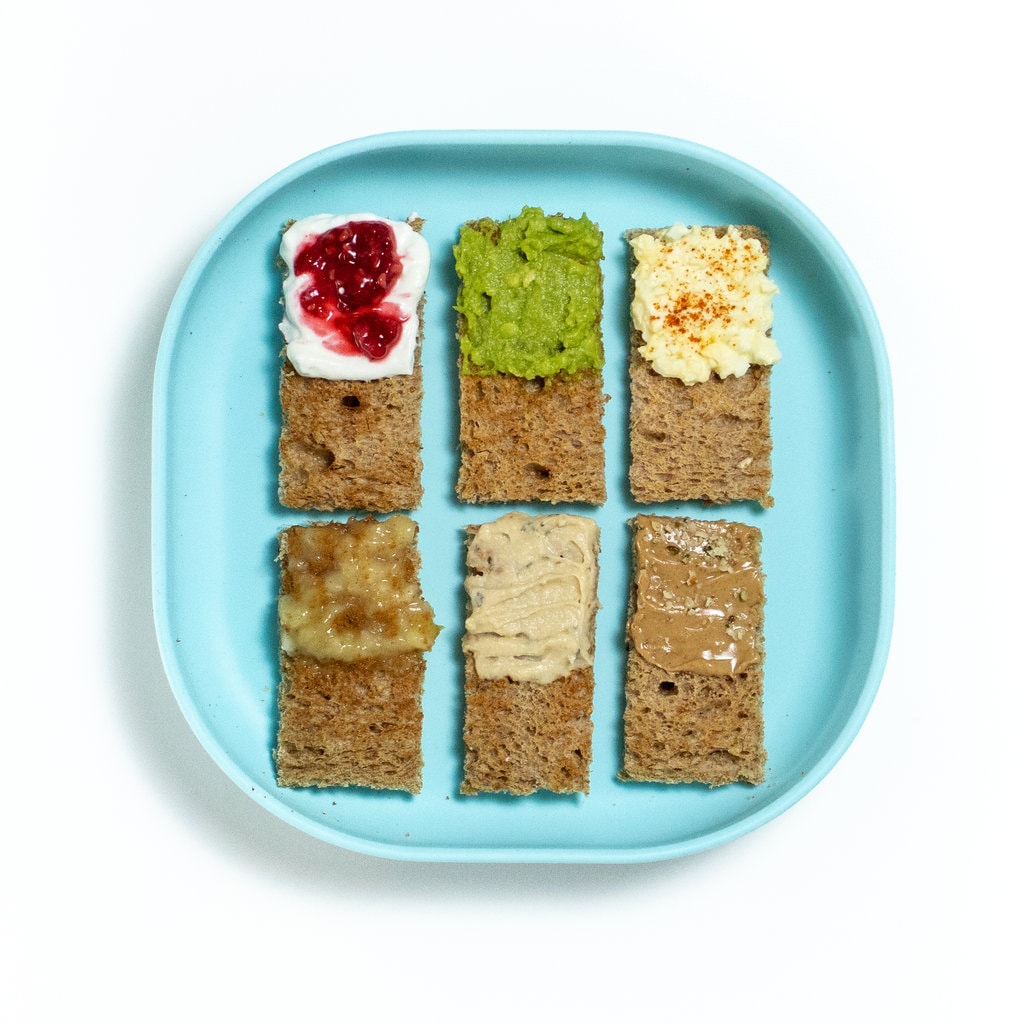
Toast Ideas for Baby
Besides being a perfect finger food for baby, spreading different foods onto toast is a wonderful way to introduce your baby to a variety of tastes and textures. Here’s several of our favorites!
- Thinly spread peanut butter or nut butter
- Mashed banana and cinnamon
- Thinly spread hummus
- Cooked and mashed beans or lentils, with a little cumin and garlic seasoning
- Mashed avocado
- Mashed hard-boiled egg yolk mixed with plain yogurt
- Thin layer of ricotta cheese with raspberry puree
- Any savory or sweet fruit or veggie puree, such as butternut squash or apple
Baby-Led Weaning Feeding Tips
- It may seem counterintuitive, but offering younger babies a larger piece of toasted, heartier style bread will actually reduce choking risks, as it is less likely to become a ball of mush in their mouth that’s sticky and hard to manage. Serving larger pieces is also easier for younger babies (6-9 months) to grasp while eating.
- If your baby tends to stuff too much bread in their mouth at once, offer more resistive types of bread, and continue to model how to tear off pieces, take bites and chew well.
- Bread made from traditional lactic acid fermentation (such as sourdough) can be a great option for baby as it contains good bacteria that help develop a healthy gut.
- Although sprouted grain breads can contain extra nutritional benefits, avoid those with whole seeds or nuts until baby is closer to 24+ months.
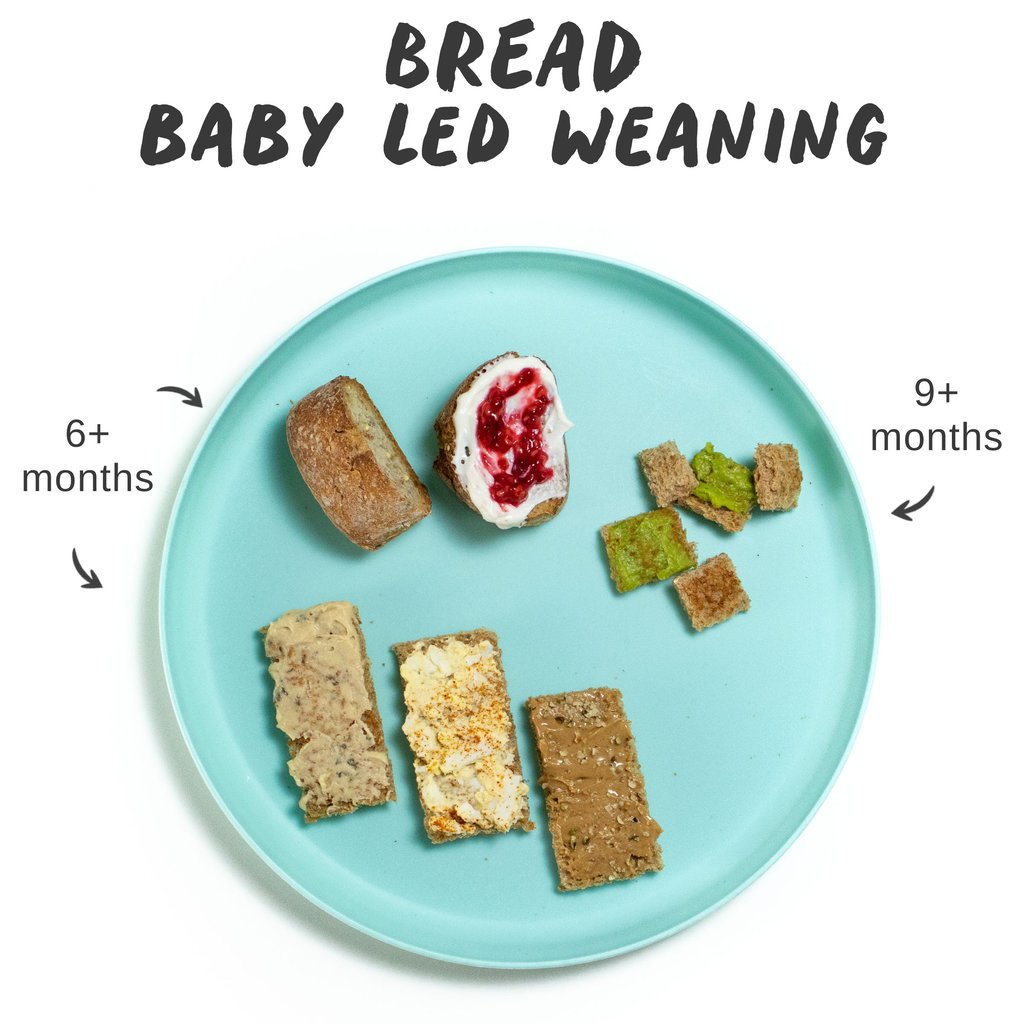
How to Serve Bread for Baby-Led Weaning
Bread can be a choking hazard for your baby, regardless of whether you are doing baby-led weaning starting at 6 months or during the finger foods stage at 9 months, so it is important to prepare and serve it properly.
Toasted, large strips or crusts of bread (6 – 9 months): Offering baby larger strips of toasted, thick crusty bread actually minimizes choking risks compared to thinner slices of soft, untoasted bread. A good rule of thumb for size of bread is about the width of two adult fingers placed together. You can serve toasted bread plain or spread a very thin layer of puree on it, such as yogurt, hummus or mashed avocado.
Toasted, cut in small strips or bite sized pieces (9 -12 months): Baby starts to develop their pincer grasp around this age, so serving bite sized pieces or thinner strips of toast will help them practice.
Toasted, cut in halves or quarters (12 – 18+ months): This is a great age to start introducing a wider variety of breads, as well as offering halves or quarters to practice biting, tearing, and chewing. Continue to experiment with a variety of spreads or topping options on bread to expose your toddler to a variety of textures and tastes. As your toddler nears 18 – 24 months they may be ready to try sandwiches, but keep in mind that sandwiches at this age will need to be kept smaller (or thin) to fit into little mouths!
How Much Bread Can Baby Have in a Day?
The amount of bread eaten will vary slightly depending on your child’s age, their appetite, and specific nutritional needs. The take-home message is that bread and other grains are just one food in your baby’s diet and shouldn’t replace other healthy foods, such as fruits, vegetables, and protein.
6-12 Months
At this age, exploration and tasting a variety of breads is the goarl. There is no set recommendations.
12-24 months
At this age, toddlers may consume about 2-3 slices of bread OR about 1-1/5 cups of cooked grains or pasta daily.
24-36 Months
Toddlers might eat 3-5-ounce servings daily, which equates to about 3-5 slices of bread OR about 1.5-2.5 cups of cooked grains or pasta daily.
Storage
Store bread at room temperature, in a cool part of your kitchen away from any heat sources. If you won’t consume bread within 1-2 weeks, slice it and store in a freezer-safe bag or container in the freezer for up to 6 months.
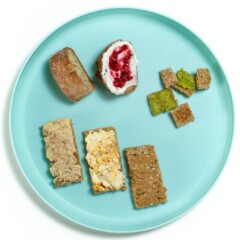
Get the recipe: Bread for Baby (plus best toast options)
Ingredients
- 1 piece bread (see best brands above)
- 1-2 tbsp toppings (see below)
Instructions
- Lightly toast bread.
- If using, smear on toppings.
- Cut into age-appropriate size pieces.
Notes
- Thinly spread peanut butter or nut butter
- Mashed banana and cinnamon
- Thinly spread hummus
- Cooked and mashed beans or lentils, with a little cumin and garlic seasoning
- Mashed avocado
- Mashed hard-boiled egg yolk mixed with plain yogurt
- Thin layer of ricotta cheese with raspberry puree
- Any savory or sweet fruit or veggie puree, such as butternut squash or apple
Did you make this recipe?
Tag @babyfoode on Instagram and hashtag it #babyfoode!

